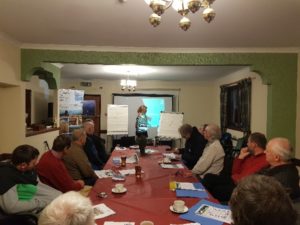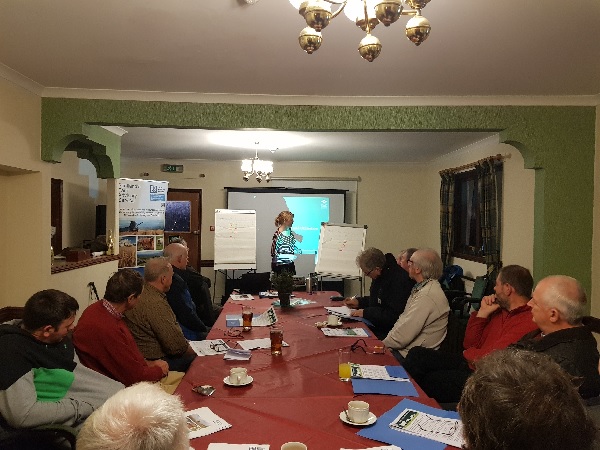Growing More Grass (Benbecula) – Event summary
13 December 2017Good grassland management is key to improving the efficiency of our sheep and beef enterprises.
This event looked at how to get the most out of the grassland on crofts to reduce reliance on other energy source for livestock. Speakers were Poppy Frater from SAC consulting and Andrew  Best from John Watson seeds.
Best from John Watson seeds.
The evening started with an informative talk by Poppy on grassland management. This highlighted the key factors involved in good grassland management and looked at how rotational grazing worked in practice. The benefits which could be achieved in terms of grassland utilisation and productivity were clearly evident. Download Poppy’s presentation slides for more information.
This was followed by a talk from Andrew Best from Johnny Watson seeds. Andrew discussed the importance of matching the seed to the soil to get the best out of it. He suggested that for a number of soils in the Uists it would be prudent to consider mixes with high proportions of diploids rather than tetraploids. He focussed on the benefits of achieving optimum pH in terms of fertiliser utilisation and grassland output.
Key points
- Target optimum pH
- Ensure soil is at target level for P and K
- Carefully select seed mix taking account of geographical location and proposed use of grass
- A short sharp graze followed by a rest period improves grass utilisation, growth and quality.
- A rotational grazing system aims to return to the first paddock around the three leaf stage, e.g. in the Spring, the tiller puts up a new leaf every 5-7 days, therefore most spring rotations are a 21 days.
- Start rotational grazing by moving the animals out of a field when the pasture height is 6-7 cm for cattle and 4-5cm for sheep. For more precise planning, calculate pasture available and divide by the flock/herd daily requirements.
Download th![]() e handouts from this event & other relevant information from below.
e handouts from this event & other relevant information from below.
For more information about how you can improve your productivity from grass, or to read what other farmers have done, visit Farming for a Better Climate.
- Technical Note (TN643): Weed Management in Grassland
- This technical note describes the most important weeds of grassland and their management. It is designed to be of value to low and high conventional input grassland systems, as well as potentially to organic systems.
- Topics: Crops and Soils
- Practical Guide: Soil sampling I – How to take a soil sample
- This practical guide details what is required to take a soil sample for analysis that is representative of the area sampled.
- Topics: Climate Change, Soils and Water Management
- Practical Guide: Soil sampling II – Benefits to your business
- This practical guide details how soil sampling can benefit businesses by increasing productivity and create efficiencies on fertiliser inputs through better nutrient planning.
- Topics: Climate Change, Soils and Water Management
- Farming For A Better Climate: Practical Guide – Soil Management
- Topics: Soils
- Farming For A Better Climate: Practical Guide – Improving Soil Quality
- This Practical Guide concentrates on how we can improve soil quality to help us to adapt to climate change.
- Topics: Soils
- Farming For A Better Climate: Practical Guide – Field Drainage
- Topics: Soils and Water Management
- Farming For A Better Climate: Practical Guide – Alleviating Soil Compaction
- This Practical Guide gives some ideas on how to alleviate soil compaction.
- Topics: Soils
Sign up to the FAS newsletter
Receive updates on news, events and publications from Scotland’s Farm Advisory Service

